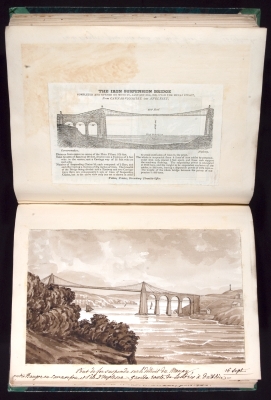
Ten items from the Lilly Library collections are part of the current special exhibition at the IU Art Museum, The Grand Tour: Art and Travel, 1740–1914, on view through December 21, 2008. (For more information, see the IU Art Museum web site). This exhibition considers the role of art and visual representation in the history of tourism. One of the great pleasures of researching the exhibition were the many hours I spent at the Lilly Library paging through rare eighteenth-century travel guides and hand-written, hand-drawn travel journals, some of which are still uncatalogued. Drawing was an important component of middle- and upper-class education during the period examined in the Grand Tour exhibition, and it is wonderful to see how the average traveler was able to put their drawing skills to use while on the road.
One of my favorite Lilly books in the exhibition is a two-volume journal (only volume one is in the exhibition) recording a walking tour in the north of Wales in September 1827, Voyage à pied dans le nord du Pays de Galles (Thiebault Family mss., uncatalogued). The journal was compiled by a French traveler, Adolphe Thiebault (1797–1875?), and is filled with his beautiful, precisely delineated ink and wash drawings of the landscapes he encountered in Wales. Each drawing is carefully pasted into the journal, and is accompanied by a descriptive caption and date. The page on view in the exhibition is particularly interesting, depicting a view of the Menai Suspension Bridge, a modern technological wonder in Thiebault’s day. Completed in 1826, the bridge was one of the world’s first iron suspension bridges. Linking mainland Wales to the island of Anglesey (previously accessible only by ferry), the bridge reduced travel time between London and Dublin from thirty-six hours to just nine. Thiebault drew the bridge on September 16, and on the facing page pasted a newspaper clipping with a story about the bridge.
Another book that provides great insight into the values and interests of its time is the very useful Gentleman’s Guide on his Tour Through Italy of 1791. If you ever wondered how long it took a Grand Tourist to travel from Rome to Naples in the late eighteenth century, this book will tell you: twenty-five hours, during which it was necessary to change horses at eighteen designated post-stations. Aside from providing detailed practical information regarding money, itineraries, and lodgings, the guidebook puts a strong emphasis on the art that English tourists wanted to see when they traveled to Italy. Lists of paintings in both private and public collections are included in the book, as is information about architecture and archaeological sites such as Pompeii, which had only been discovered a few decades earlier. Although unillustrated, the book includes a beautiful fold-out, colored map of Italy next to the title page. This book, with its map on display, is the first object visitors see when they enter the Grand Tour exhibition.
— Jenny McComas, Curator of Western Art after 1800, Indiana University Art Museum
View a larger image of a page from Adolphe Thiebault’s journal